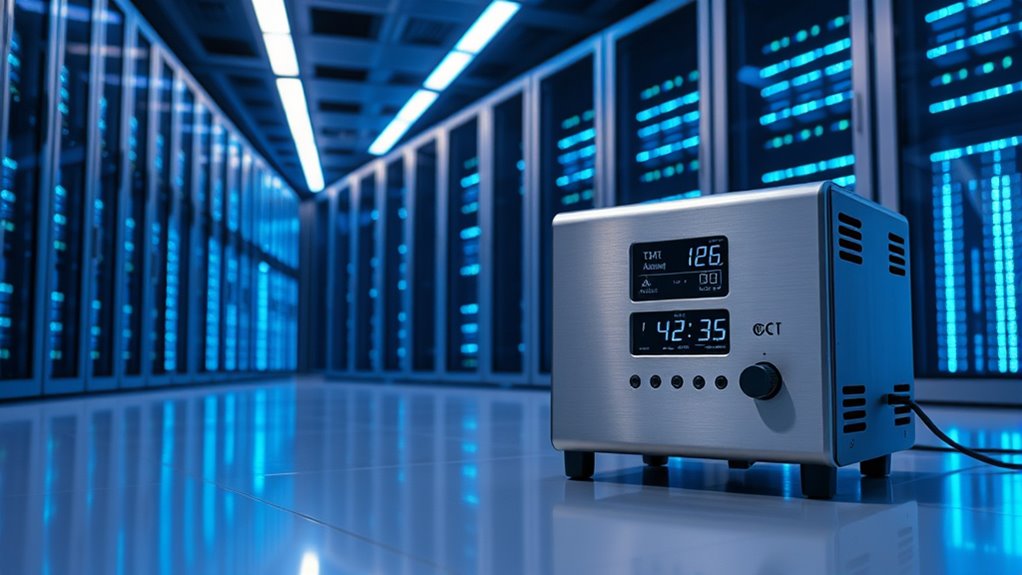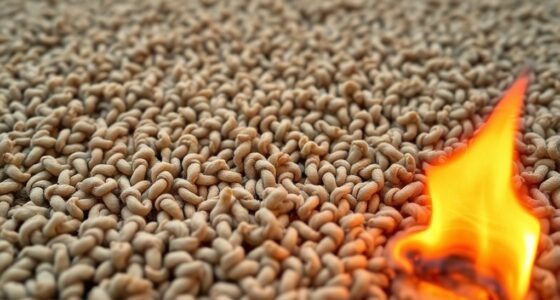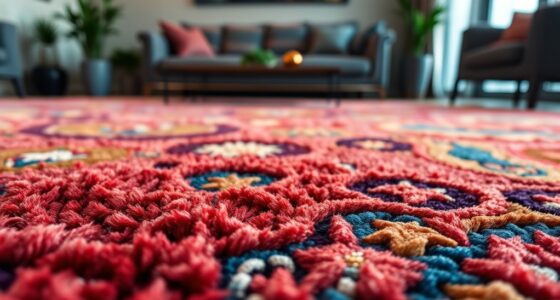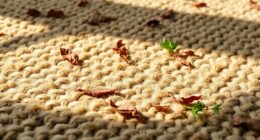To protect textiles in server-room storage, you need precise humidity control systems. Advanced sensors monitor environmental fluctuations, while automated humidifiers or dehumidifiers adjust moisture levels automatically. Combining IoT tech with smart controls ensures stable conditions, preventing fiber damage, mold, and degradation. Efficient integration with your existing infrastructure helps save energy and costs. Staying ahead with the latest humidity management tech can markedly extend textile lifespan—continue exploring to discover the best solutions for your needs.
Key Takeaways
- Implement IoT-enabled sensors for real-time humidity monitoring and automated regulation in server rooms storing textiles.
- Use advanced dehumidification systems, such as desiccant or refrigerant-based units, to maintain stable humidity levels.
- Integrate AI-driven controls to optimize humidity regulation, reducing manual oversight and energy consumption.
- Ensure sensors are localized near textile storage areas to detect environmental fluctuations precisely.
- Design system integration carefully to prevent airflow disruption and maintain server performance while controlling humidity.
The Importance of Humidity Control in Textile Storage
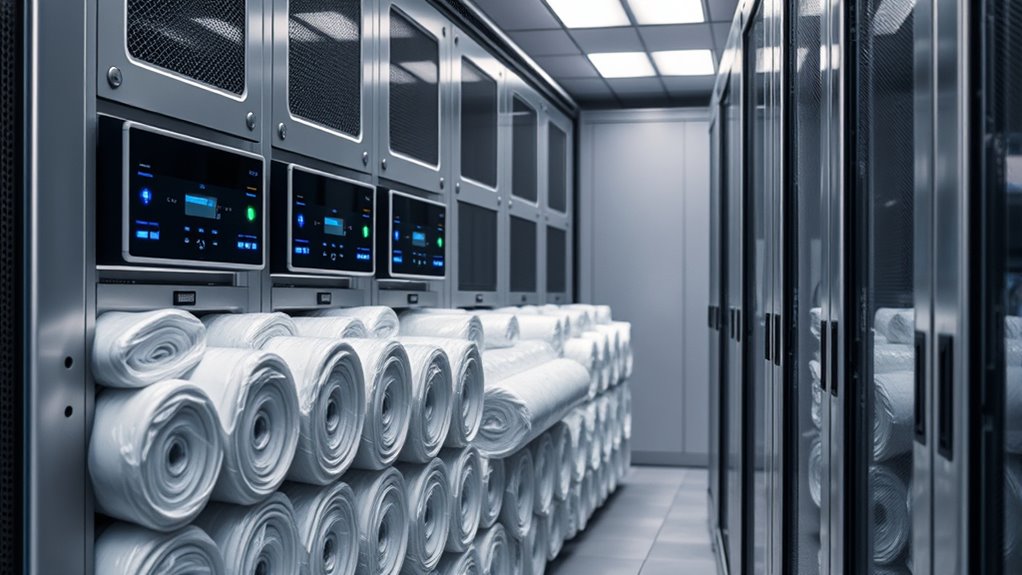
Have you ever wondered why maintaining proper humidity levels is essential in textile storage? Fluctuations in humidity can cause fiber degradation, weakening the material over time. When humidity drops too low, fibers become brittle and more prone to breaking. Conversely, excessive moisture can lead to mold growth and attract pests, damaging your textiles. Proper humidity control helps preserve the integrity and appearance of your fabrics, preventing warping, shrinking, or stretching. Maintaining consistent humidity levels is especially important when storing textiles long-term, as it directly impacts their durability and value. Proper color accuracy and humidity management are crucial for preserving your textiles’ value and condition over time. Without proper control, your stored textiles face increased risks of deterioration, which can be costly and difficult to repair. Implementing reliable humidity regulation systems ensures optimal conditions and extends the lifespan of delicate textiles.
Types of Humidity Control Technologies for Server Rooms

To effectively manage humidity in server rooms, several advanced technologies are available that guarantee ideal environmental conditions. Humidity sensors play a vital role by providing real-time data, allowing precise control of moisture levels. These sensors detect fluctuations and trigger adjustments to maintain suitable humidity. Dehumidification systems are the primary tools used to reduce excess moisture, using either refrigerant-based or desiccant-based methods. Refrigerant dehumidifiers cool the air to condense moisture, while desiccant systems absorb humidity through specialized materials. Some setups combine both technologies for enhanced accuracy. Automated controls linked to humidity sensors ensure continuous regulation, preventing issues like condensation or static buildup. Choosing the right combination of sensors and dehumidification systems helps safeguard server equipment and maintain stable conditions. Additionally, understanding AI-driven environmental monitoring can further optimize humidity control systems for maximum efficiency. Implementing automatic regulation ensures consistent performance and reduces manual oversight. It is also important to consider precise humidity levels to prevent damage caused by excessive dryness or moisture. Incorporating advanced sensor technology can further improve system responsiveness and reliability. Moreover, integrating automation in environmental control can help adapt to changing conditions more effectively.
How Humidity Affects Textile Materials and Storage Conditions
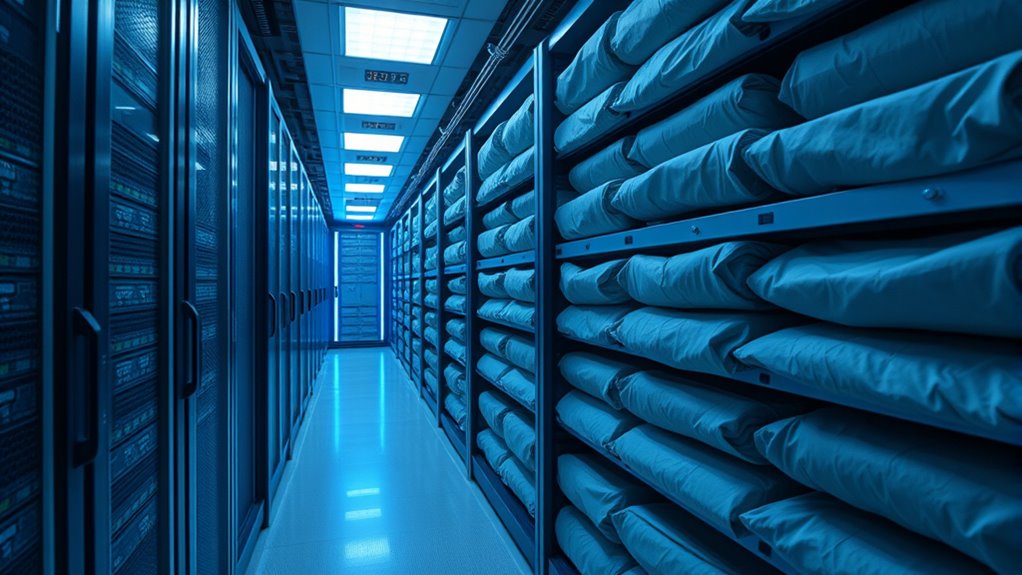
High humidity can weaken textile fibers, making them more prone to damage over time. Too much moisture creates an environment where mold and mildew thrive, harming stored materials. Maintaining the right humidity levels is essential to keep textiles preserved and in excellent condition.
Moisture’s Impact on Fibers
Moisture levels play a critical role in maintaining the integrity of textile fibers, as fluctuations in humidity can cause significant damage over time. When humidity is too high, fibers absorb excess moisture, weakening their structure and promoting mold growth. Conversely, low humidity causes fibers to become brittle, increasing the risk of breakage. Proper humidity control supports fiber reinforcement, preserving tensile strength and flexibility. Additionally, consistent moisture levels are vital during textile dyeing, ensuring uniform color absorption and preventing uneven fading. Too much moisture can lead to dye bleeding, while too little can cause uneven coloration. By managing humidity precisely, you help maintain fiber durability, prevent deformation, and guarantee high-quality textile storage. Implementing humidity regulation techniques can further optimize storage conditions and protect valuable textiles from environmental damage. Maintaining stable humidity levels also reduces the risk of environmental fluctuations that could compromise delicate fibers over time. Regular monitoring of relative humidity helps prevent sudden shifts that might harm sensitive textiles, especially when combined with climate control systems designed for optimal environmental stability.
Optimal Storage Environmental Factors
Maintaining the right humidity levels is essential for protecting textile materials during storage. Fluctuating humidity can cause fibers to expand or contract, leading to warping or fiber weaving issues. Proper humidity control minimizes these risks, preserving the integrity of textiles. For textiles that have undergone dyeing, stable humidity prevents color bleeding or fading. Excess moisture can also foster mold growth, damaging stored fabrics. Conversely, low humidity makes fibers brittle, increasing breakage risk. Achieving ideal storage conditions involves balancing humidity to support textile dyeing processes and fiber weaving, ensuring materials remain stable over time. Consistent environmental factors, especially humidity, are critical for maintaining the quality and longevity of stored textiles, safeguarding your investments from deterioration. Utilizing air quality management devices can further help regulate humidity levels effectively, emphasizing the importance of environmental stability in textile preservation.
Advanced Sensors and Monitoring Systems for Precise Humidity Management
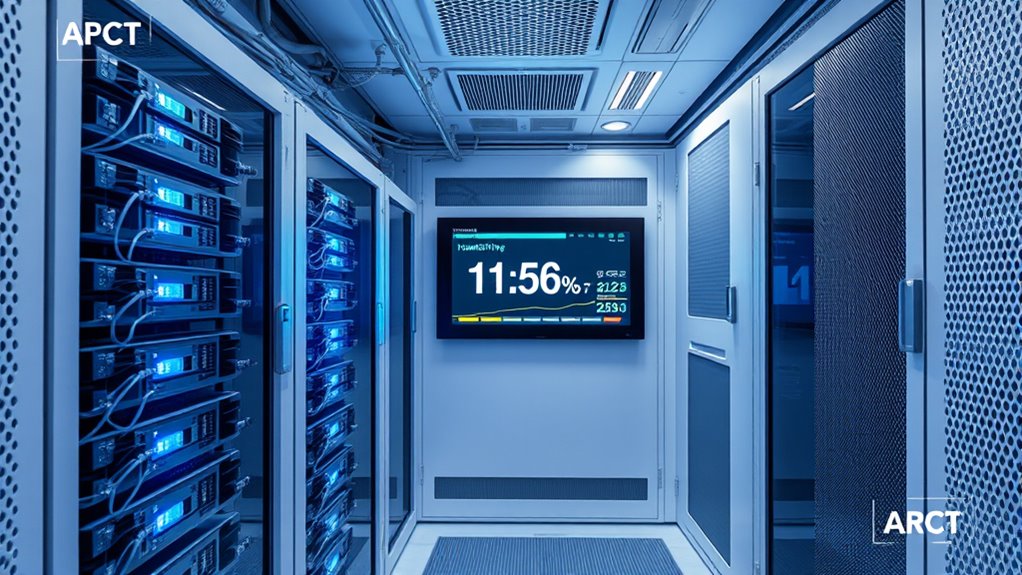
Since precise humidity control is essential for textile storage, advanced sensors and monitoring systems play a vital role in ensuring ideal conditions. These systems provide real-time data that helps you maintain optimal humidity levels, protecting fiber reinforcement and dye stability. High-precision sensors detect even minor fluctuations, enabling quick adjustments to prevent deterioration. They also facilitate detailed environmental analysis, leading to better storage decisions. Incorporating IoT technology allows seamless integration with existing infrastructure, enhancing overall control. To elevate your storage environment, consider these features:
- Multi-point sensing for extensive coverage
- Data analytics for predictive maintenance
- Remote monitoring for instant alerts and adjustments
Environmental monitoring is increasingly vital in safeguarding textiles from humidity-related damage.
Automated Humidity Regulation Devices and Their Benefits
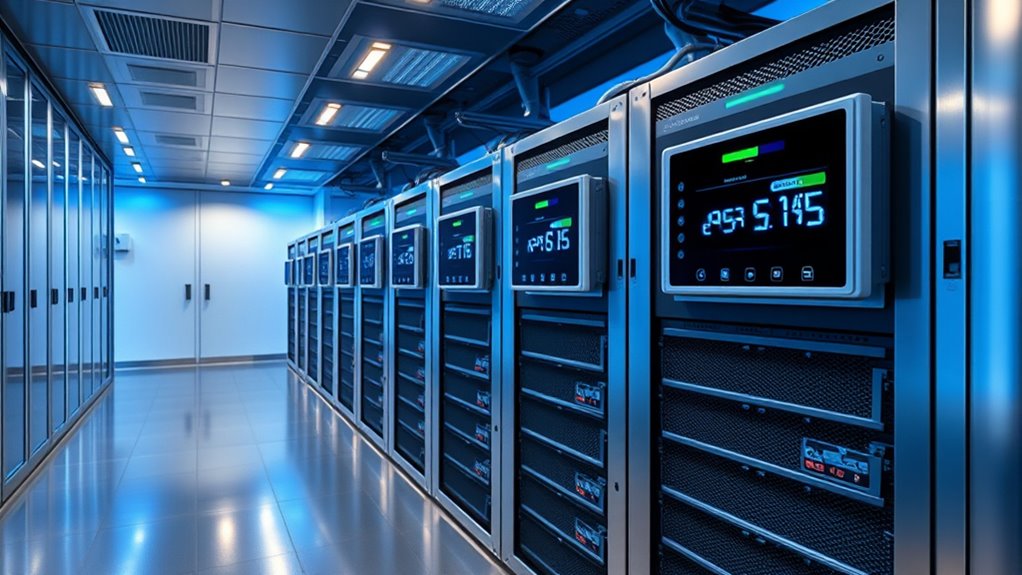
Automated humidity regulation devices give you precise control over your storage environment, ensuring consistent conditions for your textiles. By maintaining ideal humidity levels, they help reduce maintenance costs and prevent damage. Ultimately, these devices extend the lifespan of your textiles, saving you time and money. Additionally, they can adapt to environmental changes caused by wave and wind influences, helping to stabilize conditions in coastal or beach-adjacent storage facilities.
Precise Environmental Control
Automated humidity regulation devices play a crucial role in ensuring precise environmental control within server rooms used for textile storage. They help maintain stable humidity levels, safeguarding humidity sensitive equipment and preventing textile deterioration. With accurate sensors and responsive systems, you can adjust humidity in real-time, avoiding fluctuations that could compromise stored fabrics or equipment. This precision supports the integrity of textile moisture barriers, ensuring they function effectively. Incorporating these devices reduces the risk of mold, mildew, and static buildup, which can damage textiles. Additionally, consistent conditions optimize the lifespan of sensitive tech components.
- Integration with centralized control systems for seamless monitoring
- Advanced sensors for pinpoint accuracy
- Automated adjustments to prevent humidity spikes or drops
Reduced Maintenance Costs
Implementing humidity regulation devices can markedly lower maintenance costs for textile storage environments. By using advanced humidity sensors, you gain real-time monitoring that helps prevent issues caused by excess moisture. Automated dehumidification systems adjust humidity levels precisely, reducing the need for manual interventions and frequent equipment repairs. These systems minimize mold growth, fabric deterioration, and corrosion, which often lead to costly repairs and replacements. With reliable sensors and automated controls, you prevent environmental fluctuations that damage textiles, saving time and money. Additionally, these devices operate efficiently, lowering energy consumption and reducing utility bills. Investing in automated humidity regulation not only improves storage conditions but also delivers long-term savings, making it a smart choice for managing maintenance costs effectively.
Enhanced Textile Longevity
When you use humidity regulation devices, you considerably extend the lifespan of textiles stored in your facility. Maintaining ideal humidity levels prevents damage caused by fluctuations that can weaken fibers or cause dye bleeding. This is especially important during processes like textile dyeing and fabric weaving, where consistent conditions ensure colorfastness and structural integrity. Automated systems respond quickly to environmental changes, reducing the risk of mold, mildew, and fiber degradation. By preserving the quality of raw materials and finished products, you minimize costly repairs and replacements. Additionally, stable humidity levels help maintain the fabric’s natural luster and strength.
- Protects dye stability during textile dyeing processes
- Preserves fiber strength and flexibility in fabric weaving
- Extends overall textile durability and aesthetic appeal
Integrating Humidity Tech With Existing Server Room Infrastructure

Integrating humidity control technology into an existing server room infrastructure requires careful planning to guarantee compatibility and minimal disruption. You’ll need to assess your current setup to ensure the humidity systems support fiber reinforcement needs, preventing fiber degradation or damage. Proper humidity levels also promote dye stability, which is vital for textile storage. To achieve seamless integration, select devices that can be calibrated to existing environmental controls and avoid interfering with server operations. Consider installing localized sensors to monitor humidity precisely where textiles are stored. Also, coordinate with IT and facilities teams to prevent airflow disruptions or temperature fluctuations. With thoughtful planning, you can enhance textile preservation without compromising your server room’s performance or security.
Energy Efficiency and Sustainability in Humidity Control Solutions
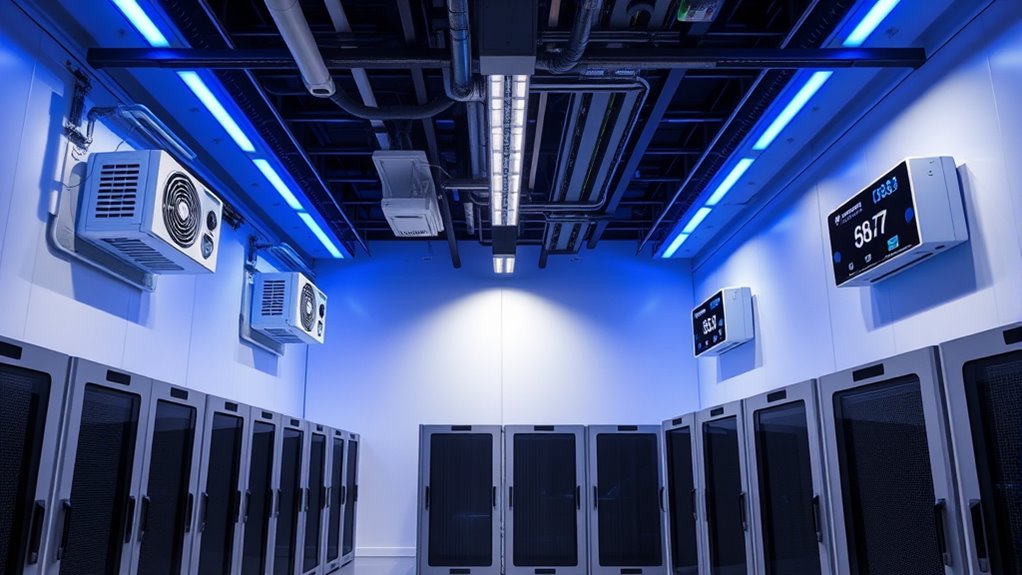
As you incorporate humidity control technology into your server room, considering energy efficiency and sustainability becomes increasingly important. Using innovative materials can reduce energy consumption and improve the system’s overall performance. Eco-friendly refrigerants help minimize environmental impact while maintaining ideal humidity levels. Look for solutions that prioritize low energy use and incorporate sustainable components to lower your carbon footprint. Implementing energy-efficient designs not only cuts costs but also aligns with green initiatives. Additionally, selecting systems with smart controls allows for precise operation, further conserving resources. To elevate your efforts, consider these key points:
Incorporate smart controls and eco-friendly materials to boost energy efficiency and sustainability in your server room humidity systems.
- Utilizing innovative materials for durability and efficiency
- Employing eco-friendly refrigerants to reduce emissions
- Incorporating smart controls for optimized energy use
Best Practices for Maintaining Optimal Humidity Levels

Maintaining ideal humidity levels in your server room requires consistent monitoring and precise adjustments. Use reliable humidity sensors to track changes in real-time, ensuring you catch fluctuations early. When humidity rises above desired levels, activate your dehumidification systems to remove excess moisture. Conversely, if humidity drops too low, consider humidifiers or adjusting existing systems. Regular calibration of sensors guarantees accuracy. To streamline control, organize your environment with a clear plan for system responses to different humidity ranges.
| Humidity Level | Action | Equipment Needed |
|---|---|---|
| Too high | Activate dehumidification | Dehumidifiers, sensors |
| Too low | Increase humidity | Humidifiers, sensors |
| Optimal | Maintain current settings | Continuous monitoring |
Future Trends in Humidity Technology for Textile Preservation

Advancements in humidity technology are shaping the future of textile preservation by offering more precise and adaptive control systems. You’ll see innovations like smart textiles and climate-responsive fibers that dynamically respond to environmental changes. These materials can adjust their properties to maintain ideal humidity levels, reducing the need for constant manual intervention. Future trends include integration with IoT devices for real-time monitoring and automated adjustments. Additionally, researchers are exploring nanotechnology to enhance moisture regulation at a microscopic level. This progress promises a more sustainable approach, minimizing energy use while protecting delicate textiles. As these technologies evolve, you’ll benefit from smarter, more reliable systems that preserve textiles more effectively and extend their longevity.
- Integration of IoT for seamless environmental management
- Development of self-regulating, climate-responsive fibers
- Use of nanotechnology to improve moisture control
Frequently Asked Questions
What Are the Cost Implications of Implementing Advanced Humidity Control Systems?
When you consider advanced humidity control systems, you should do a thorough cost analysis to understand the investment needed. They can be costly upfront, but they often save money long-term by preventing damage and reducing maintenance. You need to factor in budget considerations, including installation, energy consumption, and potential savings. While initial costs might seem high, the benefits of protecting valuable assets can outweigh these expenses over time.
How Do Humidity Fluctuations Impact the Longevity of Stored Textiles?
Humidity fluctuations can markedly accelerate textile aging, causing fibers to weaken and become brittle. You might notice discoloration or deterioration over time. Proper humidity control helps prevent mold growth, which can ruin textiles and reduce their lifespan. By maintaining stable humidity levels, you protect your stored textiles from mold and other damage, ensuring they remain durable and retain their quality longer. This proactive approach saves you money on repairs and replacements.
Are There Specific Humidity Levels Recommended for Different Textile Materials?
You might think there’s a one-size-fits-all humidity level, but for textile preservation, material sensitivity matters. For delicate fabrics like silk, keep humidity around 50%, while sturdy textiles like wool thrive at 55-60%. Ignoring these specifics risks damage, loss, and irreversible deterioration. By understanding the recommended humidity levels for each material, you safeguard your textiles and ensure their longevity for future generations.
What Maintenance Is Required for Advanced Humidity Sensors and Devices?
You need to regularly maintain advanced humidity sensors and devices by performing sensor calibration to guarantee accurate readings. Check for dust, dirt, or corrosion that could affect performance, and clean sensors as needed. Also, troubleshoot device issues promptly by verifying connections and updating firmware or software. Consistent calibration and troubleshooting help maintain reliable humidity control, preventing textile damage caused by improper moisture levels.
How Does Humidity Control Integrate With Climate Control Systems in Data Centers?
Imagine your data center as a symphony, with humidity sensors acting as vigilant conductors, guiding climate control systems to harmony. These sensors feed real-time data into your climate integration, ensuring ideal moisture levels. This seamless coordination prevents static, mold, and damage, much like a well-tuned orchestra. By integrating humidity control with climate systems, you maintain a stable environment that keeps your equipment and textiles safe and functioning flawlessly.
Conclusion
So, while your server room’s humidity tech might be busy safeguarding delicate textiles, it’s amusing how the very machines designed to keep things perfect often end up creating more chaos. Irony at its finest—your high-tech setup diligently controls moisture, yet a tiny glitch could turn your storage paradise into a textile disaster zone. Stay vigilant, because sometimes, the most advanced solutions need a human touch to truly keep things in harmony.
